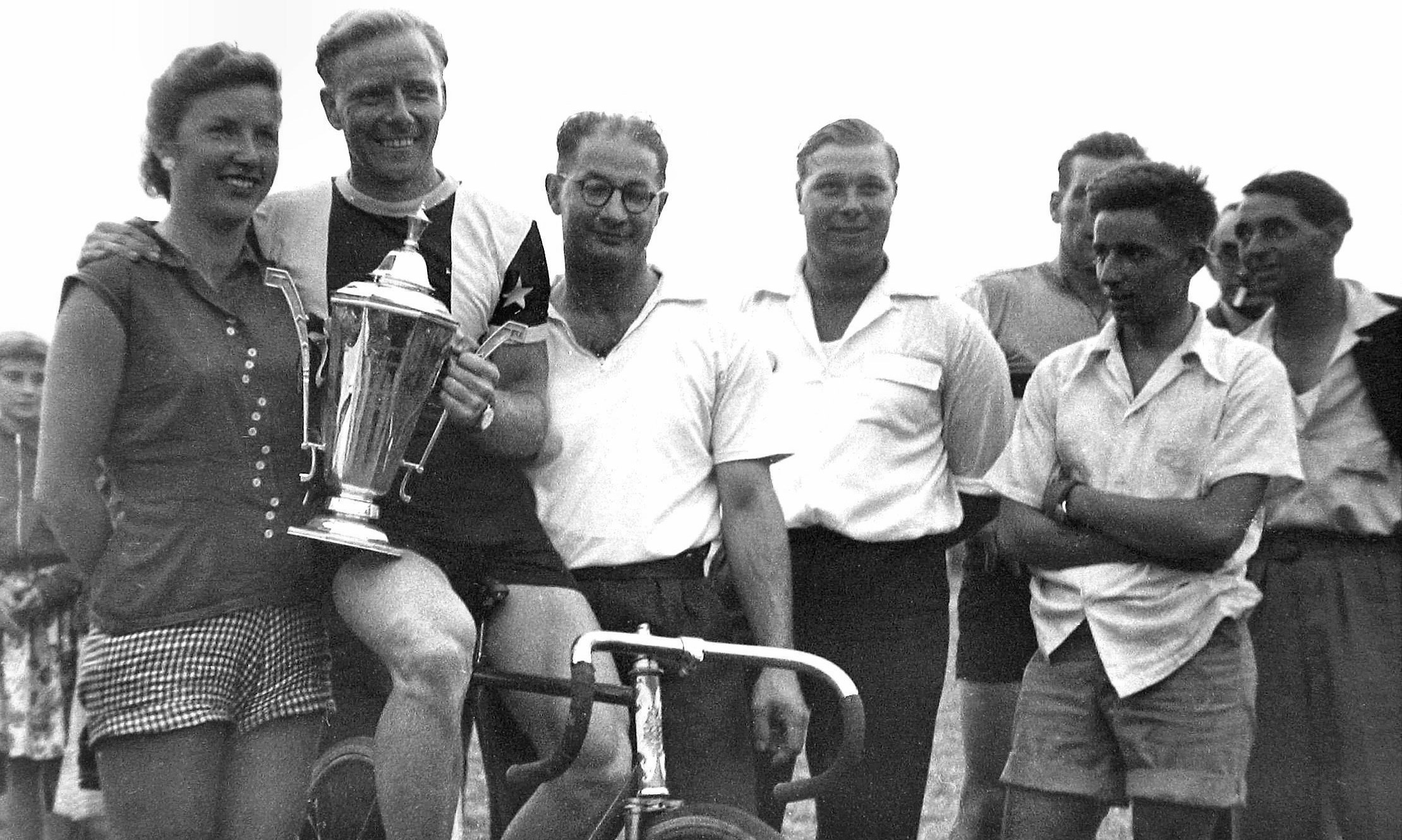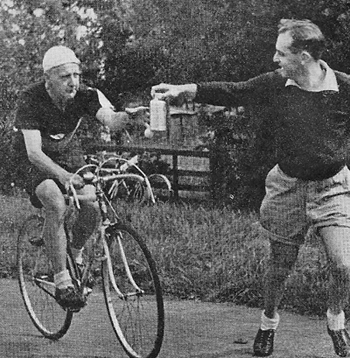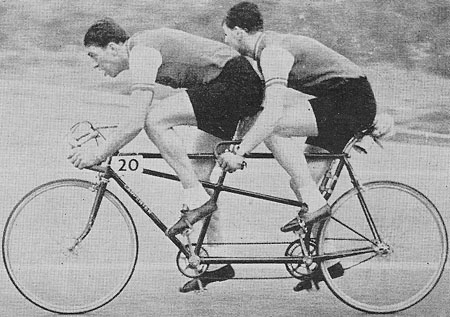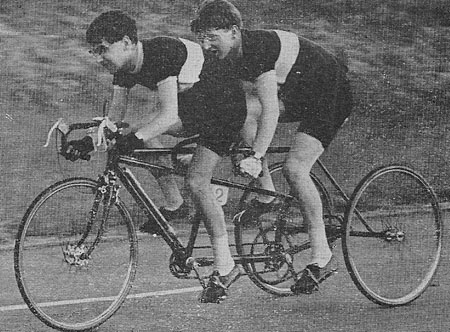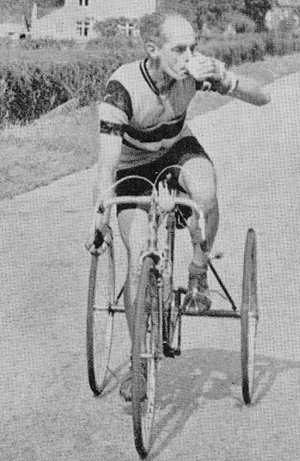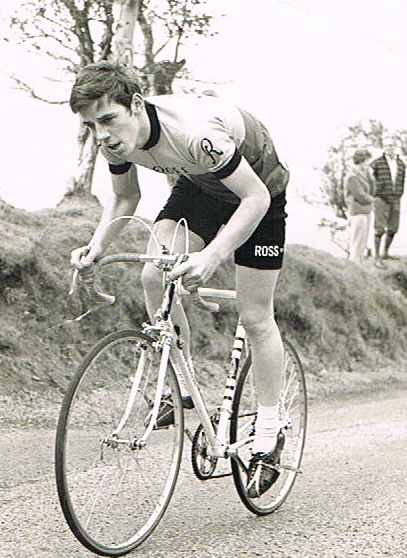Time Trials 1940's and 1950's
Posted: Saturday 22nd August 2020
In the last few years of the nineteenth century the racing of bicycles on public roads was banned, due in no small part to the lobbying of horse riders and pedestrians. Races were being wilfully disrupted, often by the police themselves, and this resulted in the National Cyclists’ Union banning racing on public roads for fear of all cycling being banned.
Independent-minded cyclists decided to organise events themselves designed to conceal the fact that they were actually racing from the general public. Thus was spawned the ubiquitous time trial where cyclists individually ride a prescribed out-and-back route timed by an official timekeeper.
It was decided that events should start at the crack of dawn and all participants must dress in black from head to toe in order for them to be less conspicuous! This way the racing was often all done and dusted by about 8am. They also decided to designate all the courses by a secret coding and to this day races are held on, for example, the ‘E10-25’. If I told you where that was then they would have to kill me! This coding system was devised to prevent any publicity for the event, possibly attracting spectators and creating the atmosphere of a race proper. Some years (1952) later Eileen Sheriden had a successful Land’s End-to-London record disallowed because a newspaper casually mentioned that it was being attempted.
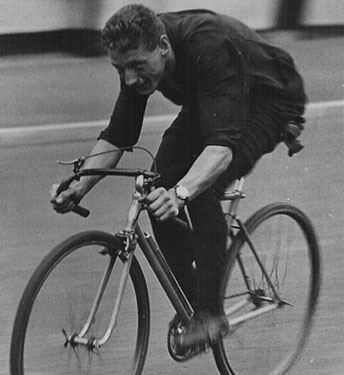
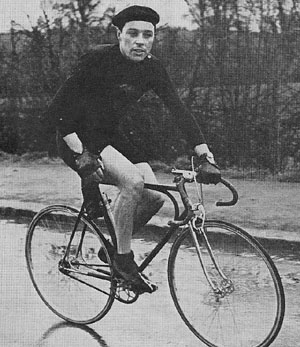
I started time trialling just after world war two and the racing was still done dressed in black from head to toe, at the crack of dawn and on courses designated by numbers – the start sheets were declared to be secret and confidential although I must admit you weren’t compelled to eat them after reading! Pre-war it had been compulsory to wear a black alpaca jacket when competing but this was dropped for post-war racing, possibly as a recognition of the fact that clothing was only available in exchange for ration tickets.
The format of a time trial was as follows: First, the event must be organised and approved by the governing body which results in the event being listed in the RTTC Handbook, the time triallists bible (now the CTT Handbook).
On the day the organisers have to arrange for a pusher-off who holds the cyclist with both feet strapped in the pedals on the start line (probably a painted or chalked line about one inch wide from the kerb out into the road for about two to three feet). Standing next to the line is the timekeeper (with an assistant for bigger events) with his stopwatch who sends the riders off at one-minute intervals; he gives a five-four-three-two-one count down at which time the pusher-off releases the rider – years ago they gave quite a push!
The club has to provide marshalls at any junction deemed to need one for safety and to stop the rider going off course. In the 40’s/50’s the ‘turn’ consisted of a turn marshall standing in the middle of the road and the rider had to spin round in the road behind him. He also shouted out his number to the turn marshall who noted all the riders’ numbers down for the timekeeper.
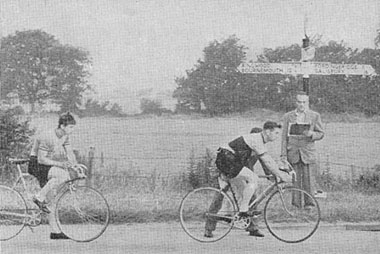
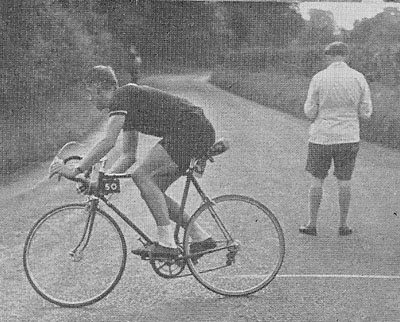
The rider then sets off as fast as he can to the finish where the timekeeper will have crossed the road to a white line on the other side. Here he positions himself to click the stopwatch as the rider speeds by, again shouting out his number. There are sometimes handicaps organised within the event as well as age-related adjustments. Quite often photographs taken in this era were of the rider manoevering around the turn, although this is not always obvious. The giveaway is the bike leaning over at about 15 – 25º and often the inside knee stuck out.
For events over fifty miles the organising club provides a feeding station where club members hand up drinks, food, and sometimes wet sponges to the passing riders. For longer rides competitors from the larger clubs would have their own feeding teams in addition to those provided by the organisers. These took care of special diets, etc. and the feeders would also check other riders times in order to give their man information on his performance in relation to his competitors.
Early post-war virtually every competitor was riding fixed-wheel for these events. In the winter riders used gears of about 64″ for training and often the first events of the season were resticted to 72″. As the season progressed riders raised the gears to about 84″ for the shorter events and 81″ for the longer 100-mile, 12 and 24-hour events.
The road/path bike was very popular amongst time-triallists in the 40’s/50’s. These would be based on a track bike of the era with short chainstays and wheelbase coupled with upright angles such as 74° head with 72° seat and track ends. People are sometimes puzzled to come across a ‘track’ frame from this era fitted with pump pegs, mudguard eyes, etc. This would have been ordered by a keen rider of the period to use in time-trials.
Looking back from our relatively affluent living style it is hard to imagine the living conditions for the years in question. Just about everything was rationed and though the war was over ration allowances were being cut even from the levels during the time of hostilties. Materials, such as steel, were in short supply and most of what was available was earmarked for export. Adverts for cycle components often stated that there was a short supply due to most production being exported.
Bearing this in mind it is surprising that such beautiful frames with elaborate lugwork and finishes were produced and even more amazing that they sold in such numbers. People were often living up to ten in a small house, which could well have no bathroom and an outside toilet. On Fridays the tin bath would be taken down from its hook on the wall and the whole family would take it in turns to have their weekly scrub; the last one in probably came out dirtier than when they went in!

Most riders had just the one machine which acted as transport to work, and was used for weekend clubruns, touring, and racing on the road and track. The mudguards were on and off like (insert your own simile here!) and the best wheels would be used for racing only with an inferior pair for general use. At factory gates, hundreds, and in some cases, thousands of workers on bikes would pour out at knocking-off time, not all clubmen of course.
Women were not allowed to compete in the same races as men so clubs had to organise separate events for them. A few clubs were formed for women only, such as the Rosslyn Ladies CC, and they organised some of the larger events.
Events were also organised for tandems. Solo trikes would compete in normal time trials for solo machines. There may be a prize for trikes (or barrows as they were known) but barrow-boys tended to pit themselves against each other in a sort of limited fraternity. Tandem trikes would compete in tandem events of course. In 1960 the ‘Uni’ 30-mile tandem event attracted 65 entries, small fry though compared with the same event in 1936 which had 135 entries for an event limited to 100 riders.
One final aspect of the time trial scene is the end of season hill climb when all the seven stone riders came into their own. Early events were ridden mainly on single-speed track frames – some with brakes, some without. Below is an image of Terry Harradine taken when several riders opted for gears. Having said that, the hill climb season still sees its fair share of single-speed machines.
“I have just read your article on time trials with the pictures of Basil Francis and Ruth Smith. I was out on a ride with a couple of friends on the Birmingham to Evesham road when we caught up with Basil who was riding in company with a lady. We rode and chatted as a group for a while when Basil said to his companion something like “see you at the usual place” and then set off at a serious pace. The lady explained that it was his usual practice, in the course of a gentle potter, to have a serious “dig” at a certain point and then wait for her to catch up. We rode on for a while until she said to me “why don`t you go after him, he would enjoy a chase”. Basil was out of sight by this time but I decided to have a go and set off, leaving my two friends to ride with the lady. Needless to say I did not catch him but found him waiting by the side of the road outside a barbers shop in Evesham where I waited with him till the group caught up. We then went our separate ways.
The picture of Ruth Smith was of interest to me because of the cars in the background, a TC M.G and a Lancia Lambda. I purchase this Lambda UU 1738, a 1929 8th series car with a shortened wheelbase and one of only two,I understand, with twin carburettor cylinder heads, in 1959 from a dealer on Coventry Road, Birmingham. I had part exchanged a Morgan three wheeler for the Lambda and was horrified to discover that the Lancia only gave about 16 miles to the gallon as compared with 40 for the Morgan. I did enjoy the Lancia and did many miles in it but the fuel costs were too much of a drain on my pocket so I went back to the dealer and did another part exchange this time for a 1928 Brough Superior J.A.P S.S.100 with alloy launch sidecar.”
Posted: Saturday 22nd August 2020
Contents
This article appears in the following categories.
Upcoming Events
Whether you are looking for a gentle social meet up, or a 100-mile ride browse the community’s upcoming events and plan your next weekend outing.
